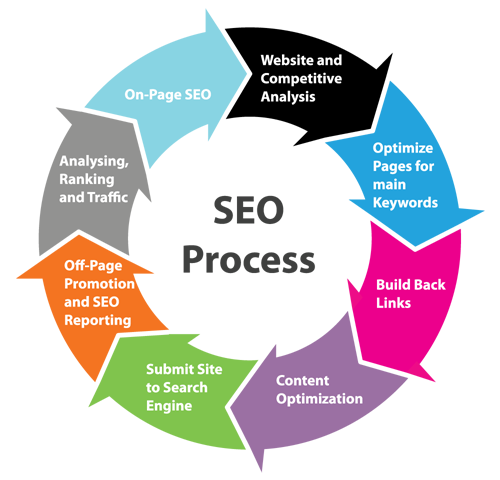In the digital age, where millions of websites compete for attention, search engine optimization (SEO) plays a key role in determining the success of a website. Whether you are a business owner, content creator, or digital marketer, understanding SEO is essential. This blog will break down SEO into its basic components: what it is, how it works, its importance and the main factors that affect it.

What is SEO?
Search Engine Optimization (SEO) refers to the process of optimizing a website or online content to rank higher in search engines such as Google, Bing or Yahoo. SEO is about making sure your content is visible to users when they search for relevant terms or keywords. Basically, it’s an art and a science of getting your website to rank higher in search engines. When someone searches for a term in a search engine, a list of websites appears. The higher your website appears in this list, the more likely users are to click on it. The goal of SEO is to drive organic (unpaid) traffic to your website by improving its visibility.
How SEO works:
Search engines like Google use complex algorithms to determine which pages to display for a given search query. These algorithms take into account hundreds of factors, which can be broadly divided into on-page and off-page elements. When a user enters a query into a search engine, an algorithm sorts through millions of web pages to display the most relevant results.
Here is a simplified explanation of how SEO works:
1. Crawling: Search engines use robots (often called “spiders” or “crawlers”) to crawl the Internet and find new and updated content on websites. These crawlers collect data from web pages and store it in the search engine’s index.
2. Indexing: Once a web page is crawled, it is indexed by a search engine. This means that website content is stored and categorized in a large database. Only indexed websites can appear in search results.
3. Ranking: When a user performs a search, the search engine searches its index to find the most relevant results. They evaluate these results based on many factors such as relevance, quality and user experience. The order in which these websites are presented on the search results page is determined by ranking algorithms. SEO involves tuning and optimizing on-page content (such as keywords, titles, and metadata descriptions) as well as off-page factors (such as backlinks and domain authority) so that search engines favor your website.
What is the meaning of SEO?
SEO is critical to the success of any online business or platform. Here are some top reasons why SEO is important:
1. Increased visibility and traffic: SEO improves the visibility of your website in search engines, which is directly related to increased traffic. Higher search engine results page (SERP) positions mean more potential customers will click on your website.
2. Builds credibility and trust: Websites that appear on the first page of search results are generally perceived as more credible and authoritative. A high search engine ranking signals to users that your content is valuable and trustworthy.
3. Cost-Effective Marketing: SEO is one of the most cost-effective marketing strategies because it targets users who are actively searching for your products or services. Unlike paid advertising, SEO-driven organic traffic can continue to deliver results long after the initial investment.
4. Improves user experience: SEO is not just about search engines. Google and other search engines favor websites that offer a good user experience such as fast loading, mobile friendliness and relevant content. Optimizing your website for SEO also improves the overall user experience, which can lead to higher engagement and conversions.
5. Competitive Advantage: Many businesses still neglect SEO and focus only on paid advertising or social media marketing. A strong SEO strategy can give you an edge over competitors who don’t invest in search engine optimization of their websites. Main SEO factors for search engines Search engine algorithms are complex, but some key SEO factors carry more weight than others in determining your site’s ranking. These factors can be divided into on-page SEO, off-page SEO and technical SEO.

1. On-Page SEO Factors:
On-page SEO refers to elements that can be optimized directly on your website: Keywords: Keywords are the foundation of SEO. You need to identify and strategically use relevant keywords in your content, title tags, headers, and meta descriptions. The goal is to align your content with what users are looking for.
Content Quality: Content should be of high quality, informative and valuable to users. Search engines favor content that answers users’ questions or solves their problems. Using multimedia (such as videos, infographics and images) also helps to engage visitors.
Meta Tags: Title tags and meta descriptions are snippets of information that describe your page to search engines and users. Optimizing these elements with keywords and short descriptions improves click-through rates.
User Experience (UX): Websites should be user-friendly, with intuitive navigation, fast loading and mobile responsiveness. A good user experience reduces bounce rates and keeps users engaged for longer.
2. Off-Page SEO factors:
Off-page SEO focuses on building your website’s reputation and authority outside of your own website.
Backlinks: Backlinks or inbound links are links from other websites to yours. Quality backlinks from reputable sites signal to search engines that your content is trustworthy and valuable. The quality and quantity of backlinks are the main ranking factors.
Social Signals: Although social media engagement is not a direct ranking factor, strong social signals (likes, shares, mentions) can help increase your site’s visibility and increase traffic.
Brand Mentions: Search engines consider both linked and unlinked brand mentions as indicators of your site’s authority. Mentions in reputable publications, forums or social media can improve your website’s reputation.



















